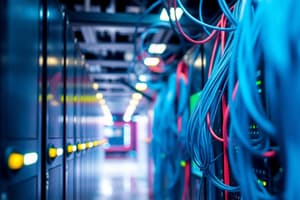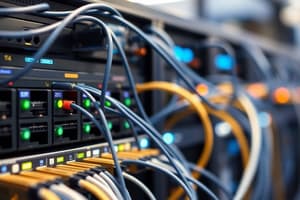Podcast
Questions and Answers
What is the primary function of an Internet service provider (ISP)?
What is the primary function of an Internet service provider (ISP)?
- To serve as a content provider for the World Wide Web.
- To connect individuals to the Internet. (correct)
- To provide domain names for users.
- To maintain web servers for websites.
Which of the following correctly describes an IP address?
Which of the following correctly describes an IP address?
- A standard protocol used to send data over the Internet.
- A numeric address that identifies computers on the Internet. (correct)
- A unique alphanumeric address that identifies websites.
- A text-based address used for email exchange.
What does a Uniform Resource Locator (URL) NOT contain?
What does a Uniform Resource Locator (URL) NOT contain?
- The protocol being used.
- The identification of the web server.
- The filename of the web page.
- The email address of the webpage author. (correct)
Which of the following statements about domain names is accurate?
Which of the following statements about domain names is accurate?
What is the typical protocol used for secure web pages?
What is the typical protocol used for secure web pages?
What component is essential for an e-mail address besides the username and the domain name?
What component is essential for an e-mail address besides the username and the domain name?
Which of the following describes a web browser's starting page?
Which of the following describes a web browser's starting page?
What is the main purpose of a search site?
What is the main purpose of a search site?
Among the following options, which is NOT a benefit of a computer-oriented society?
Among the following options, which is NOT a benefit of a computer-oriented society?
Which of the following statements regarding e-mail is false?
Which of the following statements regarding e-mail is false?
What term is often used to describe the etiquette of communication on the Internet?
What term is often used to describe the etiquette of communication on the Internet?
Which of the following risks is associated with a computer-oriented society?
Which of the following risks is associated with a computer-oriented society?
What does 'information integrity' emphasize regarding online information?
What does 'information integrity' emphasize regarding online information?
What is the primary function of a mainframe computer?
What is the primary function of a mainframe computer?
Which of the following is NOT typically a characteristic of supercomputers?
Which of the following is NOT typically a characteristic of supercomputers?
Which type of organization would most likely use a mainframe computer?
Which type of organization would most likely use a mainframe computer?
What is a key use case for supercomputers?
What is a key use case for supercomputers?
What defines a computer network?
What defines a computer network?
Which of the following is a typical feature of network servers?
Which of the following is a typical feature of network servers?
Which classification does a smartphone belong to?
Which classification does a smartphone belong to?
What is the main distinction between mainframe computers and midrange servers?
What is the main distinction between mainframe computers and midrange servers?
Flashcards are hidden until you start studying
Study Notes
Computer Networks
- A computer network is a collection of hardware and devices connected together.
- Allows users to share hardware, software, and data.
- Users can communicate with each other.
- Network Servers manage resources on a network.
- Clients access resources through the network server.
- Networks come in many sizes and types:
- Home networks
- School and small business networks
- Large corporate networks
- Public wireless networks
- The Internet
The Internet & World Wide Web
- The Internet is the largest and most well-known computer network in the world.
- The World Wide Web is a resource available through the Internet, containing a vast collection of Web pages.
- Websites contain web pages stored on web servers, viewed using a Web browser (Internet Explorer, Chrome, Safari, Firefox, Opera, etc).
- Individuals connect to the Internet using an Internet service provider (ISP).
Accessing a Network or the Internet
- Requires a modem or network adapter.
- Some networks require a username and password.
- Internet connections can be:
- Direct (always-on) connections
- Dial-up connections
Internet Addresses
- Internet addresses are used to access resources on the Internet.
- IP Address: Numeric address that identifies computers (207.46.197.32)
- Domain Name: Text-based address that identifies computers (microsoft.com)
- Uniform Resource Locator (URL): Identifies Web pages (http://twitter.com/jobs/index.html)
- E-mail Address: Identifies people for e-mail exchange ([email protected])
IP Addresses and Domain Names
- IP addresses are numeric and unique.
- Domain names correspond to IP addresses.
- Top-level domains (TLDs) identify the type of organization or its location.
- Custom TLDs may soon be allowed.
Uniform Resource Locators (URLs)
- URL: uniquely identifies a Web page.
- Consists of:
- Protocol or standard being used
- Identification of the Web Server
- Names of folders in which the Web page file is stored
- Web page’s filename
- Protocols:
- Hypertext Transfer Protocol (http://) is typically used to display Web pages (https:// is used for secure Web pages)
- File Transfer Protocol (ftp://) is often used for file exchange.
E-mail Addresses
- E-mail addresses consist of:
- Username: A person’s identifying name for a particular domain
- The @ symbol
- Domain name for the computer that will be handling the person’s e-mail (mail server)
Surfing the Web
- Web browser: Used to display Web pages.
- Browser starting or home page: The first page displayed when the browser is opened.
- To navigate to a Web page, you can:
- Type a URL in the Address bar.
- Click a hyperlink on a displayed Web page.
- Select a Favorite/Bookmark or page from the History list.
Searching the Web
- Search site: A Web page that helps you find Web pages containing the information you are seeking (typically search using keywords).
- Electronic mail (e-mail): Electronic messages exchanged between computers on a network.
- Can be conventional or Web-based.
- Can contain photos, attached files, etc.
Computers and Society
- The vast improvements in technology over the past decade have had a distinct impact on daily life, both at home and at work.
- Many benefits of a computer-oriented society:
- Ability to design products before construction leads to safer products.
- Earlier medical diagnoses.
- Devices that allow challenged people to perform job tasks.
- Documents e-mailed or faxed in moments.
- Download information, music, programs, movies, and more on demand.
Computers and Society: Risks
- Computer viruses and malware
- Identity theft and phishing
- Privacy issues
Differences in Online Communications
- Less formal than traditional communications.
- Netiquetet
- Emoticons
The Anonymity Factor
- The anonymity factor offers less accountability for actions and communication, resulting in less formal and sometimes inappropriate behavior.
Information Integrity
- Check your source, not all information on the Internet is accurate.
Mainframe Computers
- Powerful computer used by several large organizations to manage large amounts of centralized data.
- Standard choice for large organizations, hospitals, universities, large businesses, banks, government offices.
- Located in climate-controlled data centers and connected to the rest of the company computers via a network.
- Larger, more expensive, and more powerful than midrange servers.
- Usually operate 24 hours a day.
- Also called high-end servers or enterprise-class servers.
Supercomputers
- Fastest, most expensive, and most powerful type of computer.
- Generally run one program at a time, as fast as possible.
- Commonly built by connecting hundreds of smaller computers, known as a supercomputing cluster.
- Used for space exploration, missile guidance, satellites, weather forecast, oil exploration, scientific research, complex Web sites, decision support systems, 3D applications, etc.
Studying That Suits You
Use AI to generate personalized quizzes and flashcards to suit your learning preferences.




